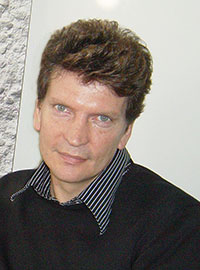Professor Henry Markram
The SEED article Out of the Blue: Can a thinking, remembering, decision-making, biologically accurate brain be built from a supercomputer? said
“In the basement of a university in Lausanne, Switzerland sit four black boxes, each about the size of a refrigerator, and filled with 2,000 IBM microchips stacked in repeating rows. Together they form the processing core of a machine that can handle 22.8 trillion operations per second. It contains no moving parts and is eerily silent. When the computer is turned on, the only thing you can hear is the continuous sigh of the massive air conditioner. This is Blue Brain.The name of the supercomputer is literal: Each of its microchips has been programmed to act just like a real neuron in a real brain. The behavior of the computer replicates, with shocking precision, the cellular events unfolding inside a mind. ‘This is the first model of the brain that has been built from the bottom-up,’ says Henry Markram, a neuroscientist at Ecole Polytechnique Fédérale de Lausanne (EPFL) and the director of the Blue Brain project. ‘There are lots of models out there, but this is the only one that is totally biologically accurate. We began with the most basic facts about the brain and just worked from there.’”
Henry Markram, Ph.D. is Project Director of the Blue Brain Project, Director of the Center for Neuroscience & Technology, and co-Director of EPFL’s Brain Mind Institute.
Henry earned his B.Sc. (Hons) from Cape Town University, South Africa under the supervision of Rodney Douglas and his Ph.D. from the Weizmann Institute of Science, Israel, under the supervision of Menahem Segal. During his Ph.D. he discovered a link between acetylcholine and memory mechanisms by showing that acetylcholine modulates the primary receptor linked to synaptic plasticity.
He went to the USA as a Fulbright Scholar at the National Institutes of Health (NIH), where he studied ion channels on synaptic vesicles. He then went as a Minerva Fellow to the Laboratory of Bert Sakmann at the Max Planck Institute, Heidelberg, Germany, where he discovered calcium transients in dendrites evoked by sub-threshold activity, and by single action potentials propagating back into dendrites. He also began studying the connectivity between neurons, describing in great detail how layer 5 pyramidal neurons are interconnected.
Henry was the first to alter the precise millisecond relative timing of single pre- and post-synaptic action potentials to reveal a highly precise learning mechanism operating between neurons — now reproduced in many brain regions and known as spike timing-dependent synaptic plasticity (STDP). These experiments were carried out in 1993, four years before publication. Although there were some correlation-sensitive findings before, this was the first study that manipulated single pre- and post-synaptic spike times to monitor the effect of synaptic changes.
He was appointed assistant professor at the Weizmann Institute for Science, Israel, where he started systematically dissecting out the neocortical column. He discovered that synaptic learning can also involve a change in synaptic dynamics (called redistribution of synaptic efficacy) rather than merely changing the strengths of connections. He also revealed a spectrum of new principles governing neocortical microcircuit structure, function, and emergent dynamics. Based on the emergent dynamics of the neocortical microcircuit he and Wolfgang Maass developed the theory of liquid computing, or high entropy computing.
In 2002 Henry moved to EPFL as full professor and founder/director of the Brain Mind Institute and Director of the Center for Neuroscience and Technology. At the BMI, in the Laboratory for Neural Microcircuitry, he has continued to unravel the blueprint of the neocortical column, building state-of-the-art tools to carry out multi-neuron patch clamp recordings combined with laser and electrical stimulation as well as multi-site electrical recording, chemical imaging, and gene expression. He has received numerous awards and published over 75 papers.
Henry coauthored Regulation of Synaptic Efficacy by Coincidence of Postsynaptic APs and EPSPs, Organizing Principles for a Diversity of GABAergic Interneurons and Synapses in the Neocortex, Real-Time Computing Without Stable States: A New Framework for Neural Computation Based on Perturbations, Interneurons of the Neocortical Inhibitory System, Dendritic Calcium Transients Evoked by Single Back-Propagating Action Potentials in Rat Neocortical Pyramidal Neurons, and Synchrony Generation in Recurrent Networks with Frequency-Dependent Synapses. He holds patent Methods For Treating And/Or Preventing Pervasive Developmental Disorders In A Subject.
Watch The Emergence of Intelligence in the Neocortical Microcircuit, Henry Markram: Designing the Human Mind, Horizon Human – Professor Henry Markram, and The Blue Brain Project. Listen to Talking Robots: Henry Markram – Blue Brain Robotics. Read Do supercharged brains give rise to autism?, IBM’s Blue Gene supercomputer to create digital 3D model of the brain, and Rewiring the mammalian brain — neurons make fickle friends.
